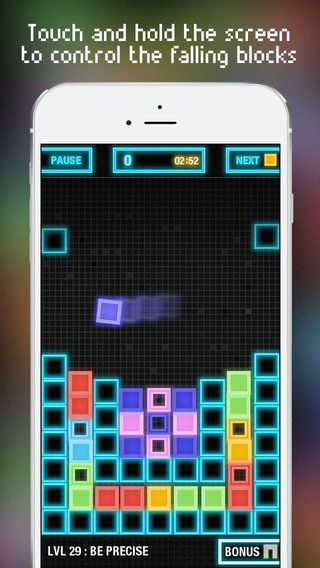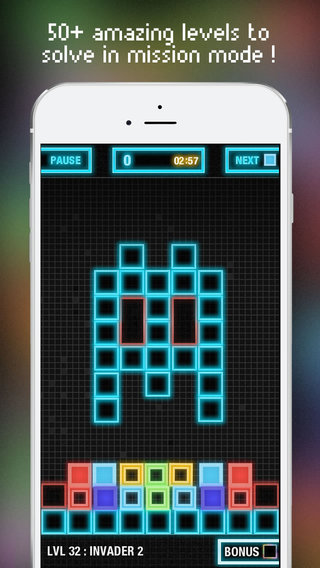Although there was a time where Tetris’s simplicity seemed like a revolutionary concept, these days falling block puzzle are often considered to be little more than dime-a-dozen experiences. It was perhaps for this reason that Julien Meyer sought to shake up the stagnating genre with a falling block game where all of the falling neon crates can be shaken up in the most literal sense possible. In Julien Meyer’s LightFields (out now, free) the blocks don’t just fall straight down, they can additionally be tilted at various angles — sometimes be pushed aside — and otherwise are at all times a slave to the laws of physics.
 Whenever three of these blocks are touching — no matter the angle at which that touching happens to occur — and they also all have the same color as well, all of the matching blocks will get removed from the playing field. After this anything either on top of those now eliminated blocks — or that perhaps were leaning against them — will now all fall down, possibly causing chain reactions if they slam into things along the way. So while removing blocks from LightFields is how you keep the screen from dangerously filling to the brim, doing so also has the potential to radically alter the rest of your playing field.
Whenever three of these blocks are touching — no matter the angle at which that touching happens to occur — and they also all have the same color as well, all of the matching blocks will get removed from the playing field. After this anything either on top of those now eliminated blocks — or that perhaps were leaning against them — will now all fall down, possibly causing chain reactions if they slam into things along the way. So while removing blocks from LightFields is how you keep the screen from dangerously filling to the brim, doing so also has the potential to radically alter the rest of your playing field.
You control these blocks — during their initial descent — by putting a finger on your iDevice’s screen, during which sliding either left or right will cause the block to go in that direction as well. Furthermore, sliding up or down will cause them to freely rotate — with the speed controlled by how far you slide — which is actually really useful since sometimes propping them up against each other is the only way to ensure they’ll touch. Finally, the currently active block’s descent will be drastically slowed down during the entire time you’re holding the screen (which can be useful for ensuring the block doesn’t bounce violently upon landing, yet can also eat up valuable time during Mission Mode).
Occasionally the blocks that fall down won’t be one of your standard colored varieties, and instead will be one of LightFields’ various — and sometimes actually helpful — Bonus Blocks. You’ll have Black Holes that consume everything they touch for a few seconds, Lightning that destroys all blocks of the first color they contact, colored Magnets that pull matching blocks towards them, and Bombs that greatly shake up the entire playing field. Whereas the Black Hole blocks — and especially the Lightning blocks, if you can correctly steer them — are absolute lifesavers when they show up, the other tend to largely be loathed and despised on arrival (especially that Bomb and all the debris it leaves behind).
Using these concepts and controls you’ll either play through LightFields in an endless Arcade Mode — which is pretty much exactly what you think it is — or through the game’s Mission Mode. The only part about Arcade Mode that might surprise people is that LightFields will dump a trash heap on the player after every 20 blocks they’ve removed, which was probably needed as it would otherwise be quite easy to get ahead of the game. When LightFields is only played for the stock Arcade mode the experience actually works rather well, but the same can’t quite necessarily be said when you instead choose to play through the Mission Mode.
 In Mission Mode players are — within a limited amount of time, usually amounting from 2 to 3 minutes — challenged to clean up all of the already existent blocks that have hollow centers, all upon a playing field already filled with obstacles and still other blocks. Sometimes before players can get to their target-blocks they’ll have to first eradicate all of the other blocks piled on top of them — sometimes they’ll have to navigate around tricky obstacles, or deal with bouncy surfaces — but mostly they’ll just fight the RNG. Whereas most other physics based puzzles — such as Angry Birds — give you your tools in a fixed order, such that the player could eventually work their way towards maximum efficiency, the blocks you’ll receive in LightFields’ Mission Mode are given at random.
In Mission Mode players are — within a limited amount of time, usually amounting from 2 to 3 minutes — challenged to clean up all of the already existent blocks that have hollow centers, all upon a playing field already filled with obstacles and still other blocks. Sometimes before players can get to their target-blocks they’ll have to first eradicate all of the other blocks piled on top of them — sometimes they’ll have to navigate around tricky obstacles, or deal with bouncy surfaces — but mostly they’ll just fight the RNG. Whereas most other physics based puzzles — such as Angry Birds — give you your tools in a fixed order, such that the player could eventually work their way towards maximum efficiency, the blocks you’ll receive in LightFields’ Mission Mode are given at random.
I have frequently had moments wherein I only had one target-block still remaining — as well as an entire minute still left on the clock — after which the RNG would proceed to not give me a single block of the needed color, which is to say nothing of the Bomb dilemma. If ever a Bomb block dropped — which was also determined by the RNG — the mission would often become completely impossible after the entire playing field had been shaken up, and yet the appearance of a Lightning block would often lead to instant victories. Quickly it became clear that often the sanest way to finish a mission stage — without forcing a specific Bonus Block to appear (more on this later) — was by learning to instantly reset a mission if things started going bad, and hope for better RNG next time.
It was also within these mission stages where it became easy to observe that LightFields’ physics were — in fact — non-deterministic, meaning that taking the precisely same action twice could lead to different results each time. There was a specific mission — by the name of Toboggan — where certain target-blocks began the stage in mid-air, they would then promptly fall the ground — bounce around a bit — and eventually come to a full rest. The catch is that they would often stop in very different places each and every time, meaning that each time I ran the level the very structure of the puzzle itself was — versus the previous run — fundamentally altered before I could even put down my first block.
So what exactly may a player control when they can’t count on Mission Mode’s puzzles to have the same starting configuration each run, their tools available to have the necessary blocks, or even for LightFields’ physics to act deterministically? This would be the player’s ability to forcefully summon any one of the game’s bonus blocks; these are a limited resource that can be occasionally earned in Mission Mode, or acquired via IAPs. Although I can’t think of any reason why you’d ever want to buy a Bomb Block, bringing forth Lighting and/or Black Hole blocks were often the only sure way around the RNG (other than constantly restarting the stage until the RNG finally deigns to help you out).
The bizarre part is — despite the fact Mission Mode seems designed purely to push IAPs — I’m not really convinced that any of this was actually done deliberately, I instead get the feeling that Julien Meyer didn’t fully understand how weird a RNG can sometimes be. Still — despite all of that — I did still decently enjoy LightFields’ endless Arcade Mode, which isn’t otherwise affected by the RNG’s whims the same way that the missions were. In fact — when you aren’t trying to reach a hyper-specific time-limited goal — the chaos caused by all the blocks violently collapsing every which way, even after a dreaded Bomb Block occurs, was often actually quite amusing to behold.
iFanzine Verdict: Julien Meyer’s decision to bring total physics to falling blocks games was certainly an interesting one, and definitely made LightFields’ endless Arcade Mode a unique experience like you’ve never before seen. On the other hand: the game’s non-deterministic physics — coupled with boxes given according to a RNG’s whims — means that Mission Mode can often become a pure hell, unless you use IAPs. This all results in a free iOS game that is actually halfway awesome (specifically the Arcade Mode half), and — should Julien Meyer later change how the Mission Mode functions — may even potentially become 100% awesome at some point in the future.

